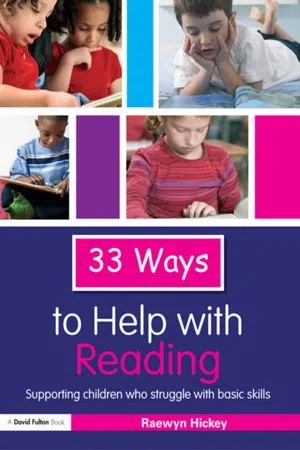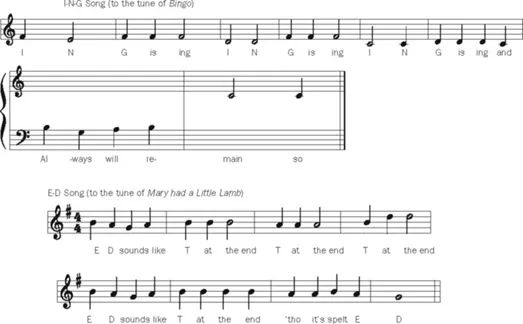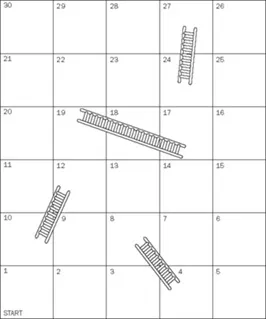
33 Ways to Help with Reading
Supporting Children who Struggle with Basic Skills
- 108 pages
- English
- ePUB (mobile friendly)
- Available on iOS & Android
About This Book
Thirty Three Ways to Help with Reading equips teachers and teaching assistants with a wide range of practical resources to help children who are having difficulties learning the basic skills of reading.
By providing a range of activities and games which engage children and encourage motivation in the classroom, the book provides ready-to-use material that doesn't need lengthy forward preparation. These practical and fun ideas incorporate a range of learning styles, using kinaesthetic and auditory techniques, which put the emphasis on 'games' rather than 'work'. The activities are therefore ideal for use with children who do not benefit from a traditional approach to reading. The book works step-by-step through activities which cover the key stages in the process of learning to read:
-
- Learning letters
-
- Recalling frequently used words
-
- Hearing sounds in words
-
- Blending sounds
-
- Reading for meaning
The 'how to help' approach of the book is ideal for teachers and teaching assistants wanting to give quality learning experiences for those children experiencing difficulties with reading. With all the resources needed for the games included, the book provides quick and easy to use ideas, which can be implemented instantly in the classroom.
The Routledge '33 ways…' series of practical 'how-to' books is for teachers, teaching assistants and SENCOs who are in need of fresh ideas to teach pupils in their care who are struggling with basic skills. It provides them with the tools to make good provision for a range of children in their class, and are planned to be a resource from which they can extract ideas and materials without having to plough through chapters of theory and research.
Raewyn Hickey is an experienced classroom teacher who has worked in both the Literacy Initiative for Teachers project in Westminster and as a consultant for the Primary Strategy.
Frequently asked questions
Information
D. Making links: phonics
Blending letter sounds
- When decoding new words.
- When the word contains a digraph.
- Children must be able to notice when words contain vowel or consonant digraphs.
- Children must know two vowels together make one sound, for example, ea, ai, oa, ou.
- Pronounce the letter sounds as ‘cleanly’ as possible. That means you need to be very careful how you say the sounds.
| rrr | not | ruh |
| I | not | luh |
| mmm | not | muh |
| ch | not | chuh |
- For the children who have found blending a difficult skill, hearing sounds pronounced with uh at the end and copying that sound, then makes blending letters together even more difficult.
- You may need to ask a colleague to listen to you say the sounds if you are unsure. It is often difficult to hear your own pronunciation.
Verb endings


Resources
- One bean bag.
- Whiteboards or card.
- Felt tip pen.
Preparation
- Write the following words onto small whiteboards or card, one word on each. most, camp, small, bend, tram, still, yelp
- Place a marker on the floor to indicate where the child should stand to throw the bean bag.
- Put the cards randomly on the floor, each at a different distant from the marker.

- Ask the child to throw the bean bag so that it lands on a word, or lands as close to it as possible.
- Ask him to read the word the bean bag landed on or the closest one to it, by sounding out each letter quickly and joining the sounds together.
- Encourage the child to sound the letters without pausing between each sound.
- If you want to add an element of competition, you could give the child a point for every word he can read correctly: double points can be given for the word he finds most challenging. When playing the game on other days, the child can see if he can improve his score.
Extension
- Choose words with five or more letters.

Resources
- Photocopy of Ladder Sounds game board on page 51 enlarged to A3 size.
- Photocopy of Ladder Sounds cards on page 52.
- Dice.
- Counters — one for each player.
Preparation
- Cut the Ladder Sounds words into individual cards and place face down in a pack near the game.
Rules of the game
- A player throws the dice and moves his counter the corresponding number of squares.
- If his counter lands on a square with a ladder in it, he turns over a card and blends the sounds to read the word.
- If he reads the word correctly he moves up the ladder.
- The winner is the first person to reach 30.

Activity
- Say: Today we are going to play a game called ‘Ladder Sounds’. First, put your counter in the first square to start.
- Ask the child to throw the dice and move the corresponding number of squares. Then take your turn.
- If either the child's or your counter lands on a square with a ladder, say: When you land on a square with a ladder in, you turn over the top card in the pile and read the word by blending the sounds together. If you can read the word you can move your counter up the l...
Table of contents
- Cover Page
- Half-Title Page
- Thirty-Three Ways to Help with Reading
- Title Page
- Copyright Page
- Table of Contents
- The series
- Acknowledgements
- Introduction
- A. Beginnings Activities:
- B. The alphabet Activities:
- C. Learning highfrequency words Activities:
- D. Making links: phonics Activities:
- E. Letter patterns Activities:
- F. Making sense of text Activities:
- Glossary